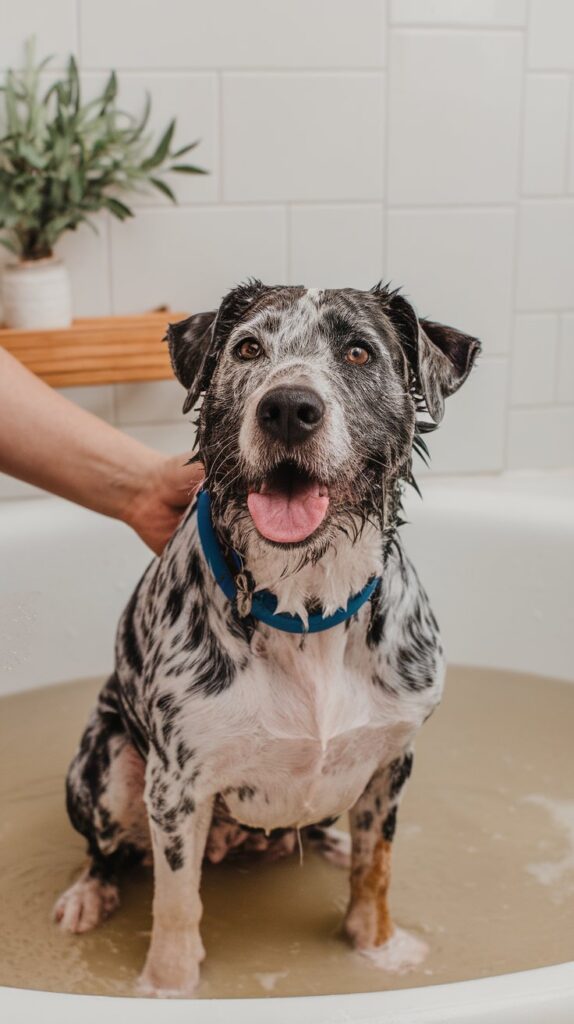7 Vet-Approved Remedies for Dog Rashes
So, your dog is itching, scratching, and rubbing against every possible surface like they’re trying to start a fire? Yep, sounds like a rash.
The good news? Most dog rashes are treatable at home—IF you know what you’re doing. The bad news? Ignoring it could make things worse.
Before you panic-Google “dog rash causes” and convince yourself it’s something rare and terrifying, let’s go over 7 remedies to help your dog feel better—without making things worse. And if you’re not sure – always consult with your vet!
1. Oatmeal Baths (Because Spa Days Aren’t Just for Humans)

If your dog has red, itchy, inflamed skin, an oatmeal bath might be exactly what they need. Oatmeal has anti-inflammatory properties that help soothe irritation and relieve itching.
How to Do It:
- Grind plain oats (NOT the sugary, flavored kind) into a fine powder.
- Mix it into a lukewarm bath (NOT hot—hot water makes rashes worse).
- Let your dog soak for 10-15 minutes, then rinse gently.
- Repeat a few times a week as needed.
Why It Works:
Oatmeal creates a protective barrier on the skin and helps reduce inflammation. Plus, your dog will smell like breakfast, which is a bonus.
🍲 50 Printable Dog Food Recipes Your Pup Will Love
Skip the fillers and preservatives. Make healthy, homemade meals your dog will actually eat — using everyday ingredients you already trust. Vet-friendly, budget-friendly, and super easy to follow. 🐾
Perfect for picky eaters, senior dogs, and pups with sensitive stomachs. Make mealtime simple and nutritious again.
Get the Recipes Now 🐶2. Coconut Oil (AKA Nature’s Miracle Moisturizer)

Coconut oil is basically the Swiss Army knife of natural remedies. It’s antibacterial, antifungal, and deeply moisturizing, making it perfect for soothing dry, itchy skin.
How to Use It:
- Apply a small amount to the affected area (don’t overdo it, or your dog will turn into a greaseball).
- Gently massage it in and let it absorb.
- Use once or twice daily until the rash improves.
Why It Works:
Coconut oil hydrates dry skin and has natural antimicrobial properties, which can help with bacterial or fungal-related rashes.
Heads Up: Some dogs love the taste of coconut oil and may try to lick it off. If that happens, try covering the area for a bit or distracting them with a chew toy.
3. Aloe Vera (Cool, Soothing, and Dog-Safe)
- Soothing Hot Spots: Hot spots can be a real source of discomfort for your dog. Raslok Aloe Vera Gel is expertly crafted …
- Healing Power for Cuts and Scrapes: Minor cuts and scrapes are a part of every dog’s life. Our Aloe Vera Gel promotes th…
- Relief from Dry and Itchy Skin: Dry, itchy skin can lead to incessant scratching and discomfort. Our gel works wonders b…
Aloe vera isn’t just for human sunburns—it’s also great for calming inflamed, itchy skin on dogs. But BE CAREFUL—not all aloe products are dog-safe. ONLY use pure aloe vera gel (without alcohol or additives).
How to Apply:
- Use fresh aloe gel from the plant (or a dog-safe version from the pet store).
- Apply a thin layer to the rash 2-3 times a day.
- Let it dry before your dog can lick it off.
Why It Works:
Aloe vera is cooling, anti-inflammatory, and hydrating, making it perfect for irritated skin.
Warning: The actual aloe plant contains compounds that can be toxic if ingested, so don’t let your dog chew on it.
4. Apple Cider Vinegar (Only for Certain Rashes—Dilute It!)

Apple cider vinegar (ACV) is great for bacterial and fungal skin infections, but do NOT use it on open wounds or raw skin—because ouch. If your dog’s rash is mild and not raw, ACV might help restore skin balance and fight off microbes.
How to Use It:
- Dilute ACV (50% ACV + 50% water) before applying.
- Use a cotton ball or spray bottle to gently apply it to the rash.
- Repeat once or twice daily.
Why It Works:
ACV is antibacterial and antifungal, which makes it great for yeast infections, mild hot spots, and irritated skin.
BUT: If your dog has raw, broken, or sensitive skin, skip this one—it will sting like crazy.
5. Chamomile or Green Tea Soaks (For the Fancy, Herbal Approach)

Chamomile and green tea have natural anti-inflammatory and soothing properties, which can help calm irritated skin.
How to Use It:
- Brew a strong cup of chamomile or green tea, then let it cool.
- Soak a clean cloth in the tea and gently press it on the rash.
- For larger rashes, pour the tea into a spray bottle and lightly mist your dog’s skin.
- Repeat 1-2 times a day.
Why It Works:
Chamomile and green tea help reduce redness, inflammation, and irritation—and they smell nice, which is a bonus.
6. Omega-3 Supplements (Fix It from the Inside Out)
- Effective dog skin and coat supplement:Omega skin and coat chews for dogs help support dog health from the inside out. F…
- Fish oil supplements for dogs more benefits: Dog omega 3 supplement can be used for dog allergy relief, itching relief f…
- Skin supplements for dogs are great value for money: Omega bites for dogs are made from natural ingredients and do not c…
Sometimes, rashes happen because your dog’s skin is dry, irritated, or inflamed from the inside. Adding Omega-3 fatty acids to their diet can help reduce inflammation and improve skin health over time.
How to Use It:
- Look for high-quality fish oil or Omega-3 supplements (vet-approved, of course).
- Add it to their food daily.
- Be patient—it can take a few weeks to see full results.
Why It Works:
Omega-3s help keep your dog’s skin hydrated and less prone to irritation, making rashes less likely to happen in the first place.
7. Hydrocortisone Cream (The Vet-Approved Itch Relief)
- 1% Hydrocortisone Spray for Rapid Relief from Skin Irritations Caused by Bites and Other Skin Conditions.
- Itch Relief For Dogs And Cats: Our Hydrocortisone Treatment Reduces Inflammation, Swelling, Itching, and Redness to Help…
- Non-stinging Formula: No Fragrance or Dyes Helps Relieve Itching Without Causing Further Irritation to the Skin.
If your dog’s rash is really bothering them, a small amount of hydrocortisone cream (1%) can help reduce inflammation and itching. This is one of the few over-the-counter treatments that vets actually recommend.
How to Apply:
- Use a pea-sized amount on the rash.
- Prevent licking (use a cone if necessary).
- Apply once or twice a day, but only for a few days (long-term use can thin the skin).
Why It Works:
Hydrocortisone quickly reduces redness, swelling, and itching—great for hot spots, mild allergic reactions, or irritation.
When to See the Vet
While these home remedies work for mild, common rashes, some skin issues need professional treatment. If your dog has:
🚨 Severe redness, swelling, or pain
🚨 Open sores or raw skin
🚨 Excessive hair loss
🚨 Foul-smelling discharge
🚨 A rash that doesn’t improve in a few days
… it’s time to call the vet. Some rashes are caused by infections, allergies, or underlying health issues that need medical treatment.
Final Thoughts
Dog rashes are annoying but usually treatable—if you catch them early and use the right remedies. Whether you go for an oatmeal bath, coconut oil, or a vet-approved hydrocortisone cream, the goal is simple: stop the itch, soothe the skin, and keep your pup happy.
Now go give your dog some belly rubs—they deserve it after all that scratching. 🐶💕

I’ve spent 10+ years in dog training, digging into what makes dogs (and their humans) tick. At Smart Dog Learning, I share my no-nonsense, fun approach to training so you can enjoy life with a well-behaved, happy pup—no boring lectures, just practical results 😉








